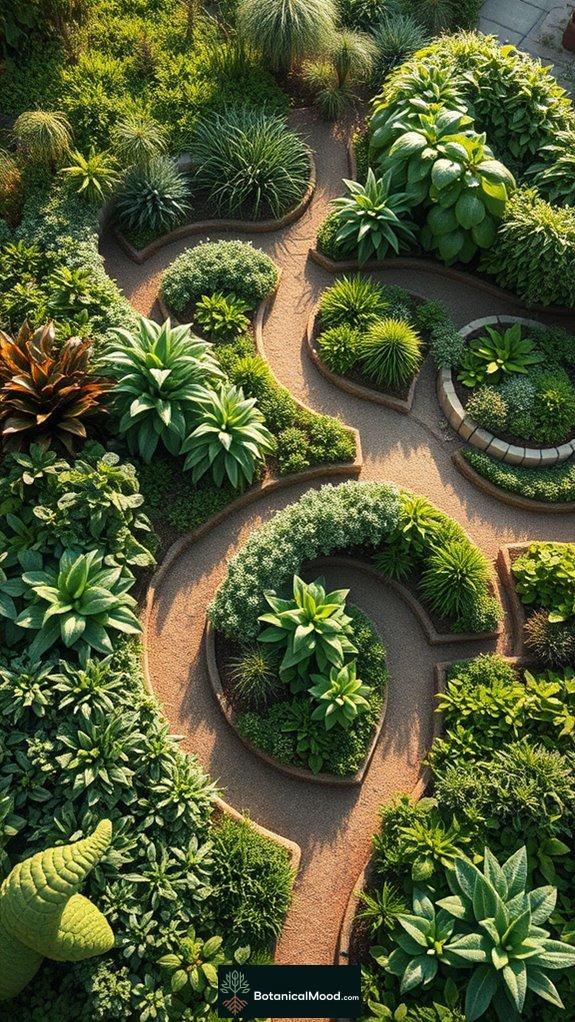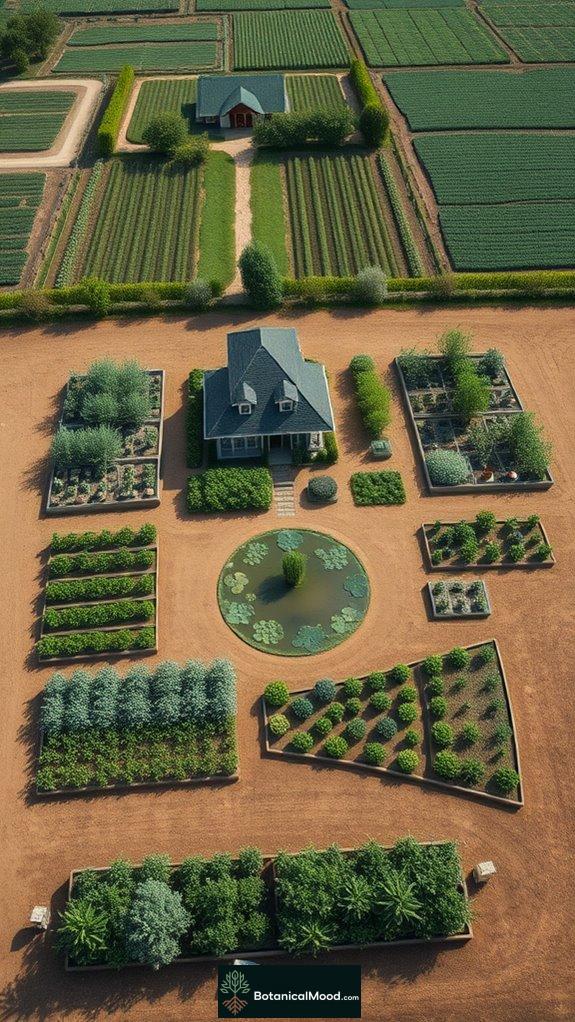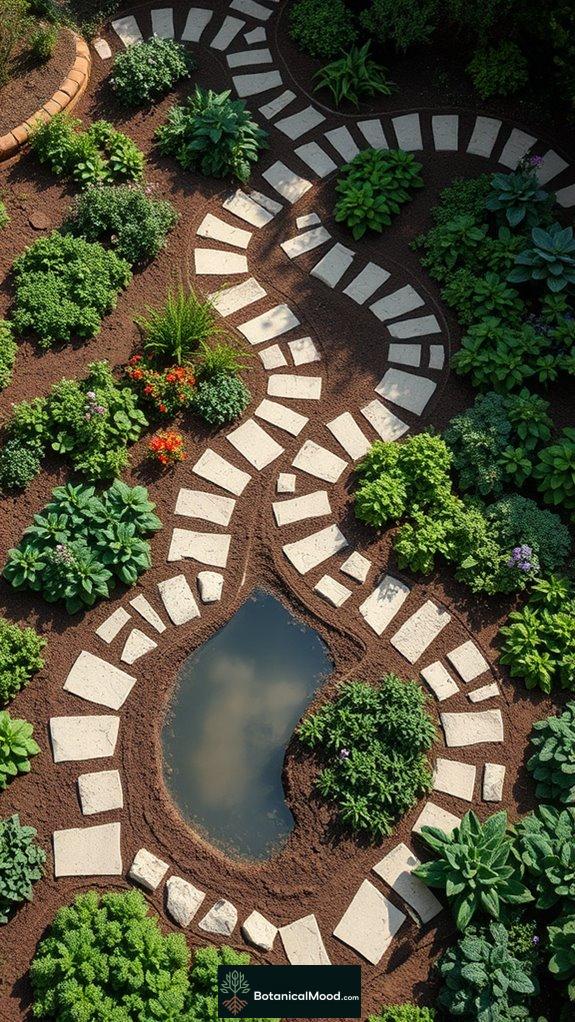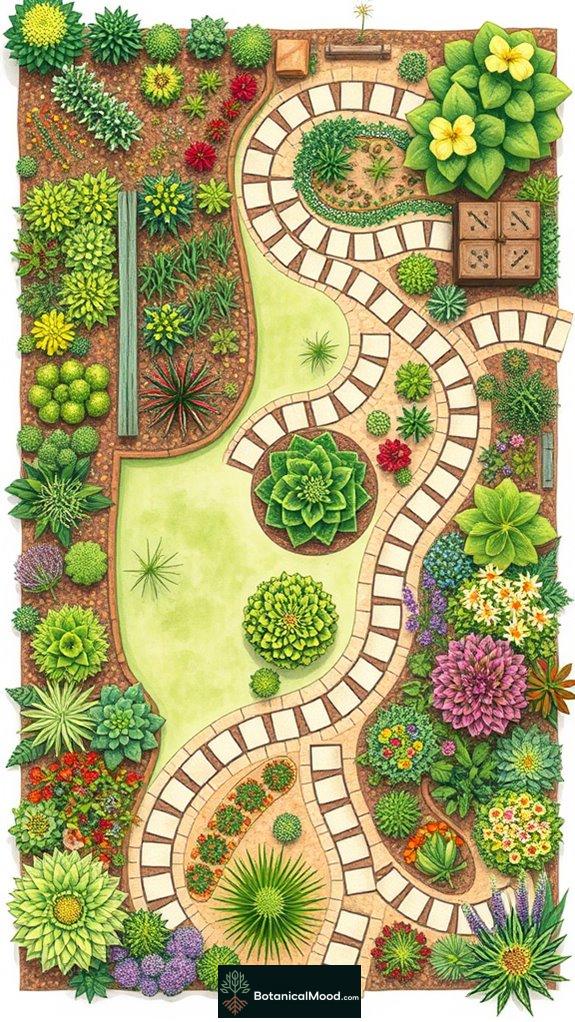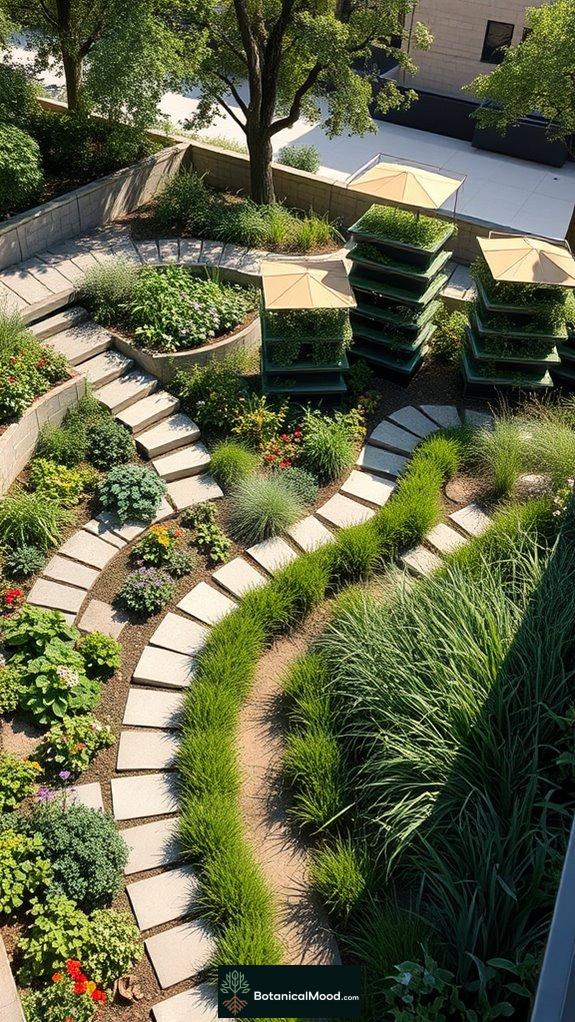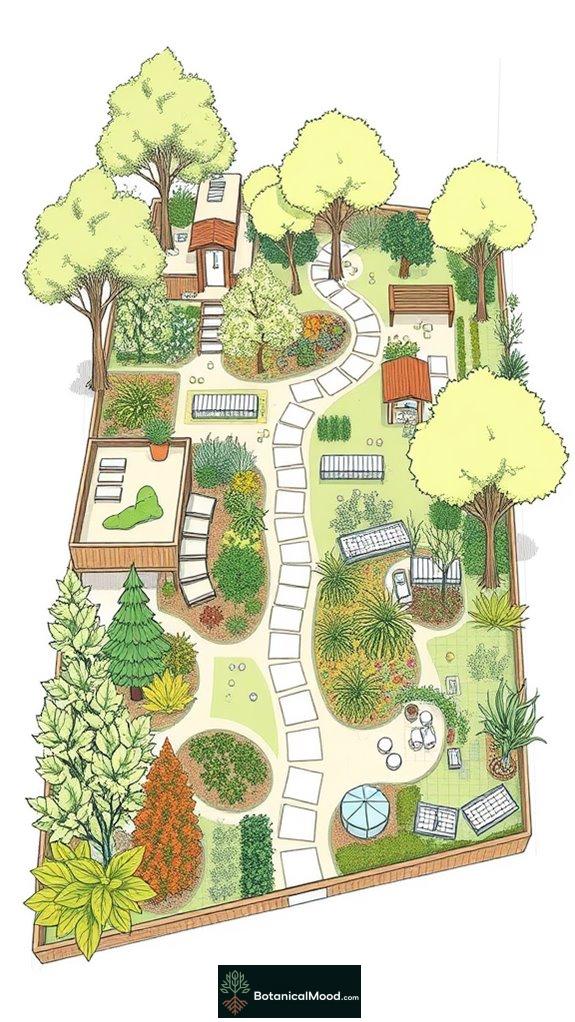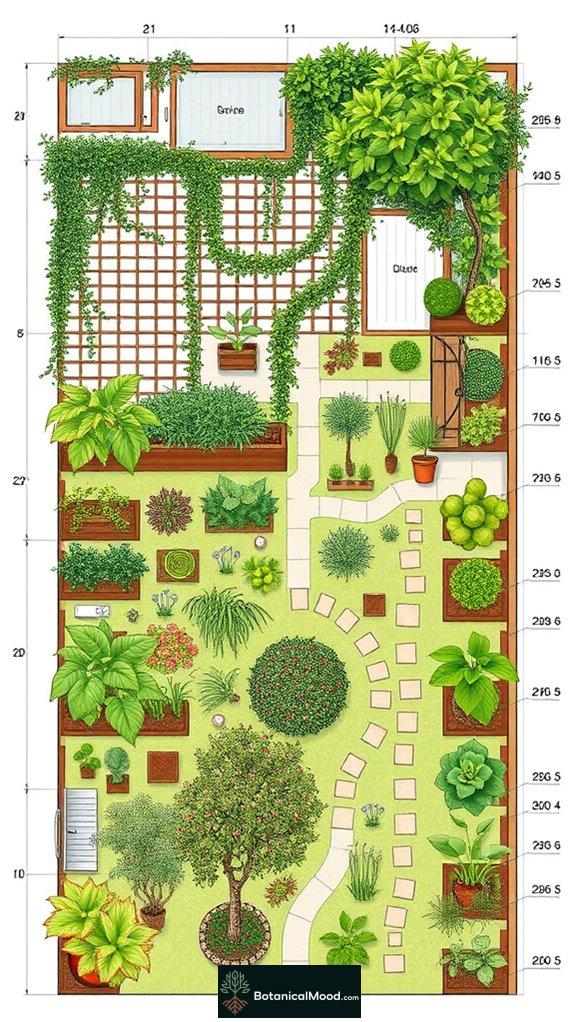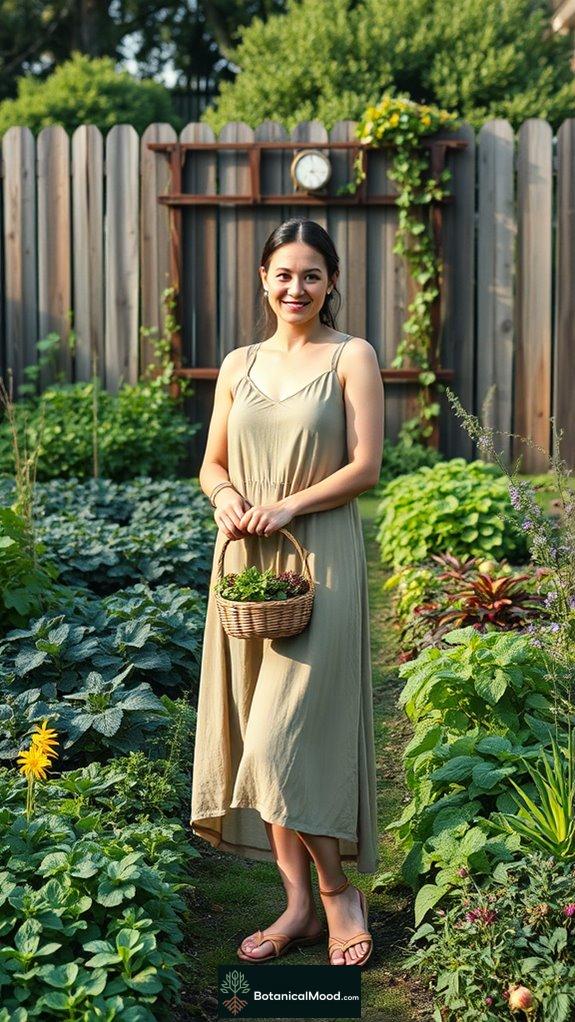Permaculture gardens showcase a variety of layouts that support sustainable living by harmonizing design with nature. Food forests, with their layered planting, enhance biodiversity while providing year-round harvests. Herb spirals maximize space through microclimate diversity, making efficient use of resources. Vertical and container gardens offer solutions for limited urban spaces, creating vibrant green retreats. Incorporating rainwater harvesting systems bolsters eco-friendliness, ensuring gardens thrive. Exploring these permaculture concepts can inspire a flourishing garden that nurtures both beauty and sustainability. Discover even more innovative designs and ideas ahead.
Quick Takeaways
- Food forests mimic natural ecosystems, promoting biodiversity and sustainable food production through layered planting and companion planting techniques.
- Herb spirals maximize space and create diverse microclimates, enhancing herb productivity while requiring minimal maintenance.
- Vertical gardens transform small spaces into green areas, improving air quality and urban aesthetics using modular planters and hydroponic systems.
- Container gardens are ideal for urban settings, offering mobility and better soil control while attracting beneficial insects and enhancing biodiversity.
- Incorporating rainwater harvesting and swales improves water efficiency and soil health, essential for resilient permaculture garden designs.
Food Forests for Abundant Harvests
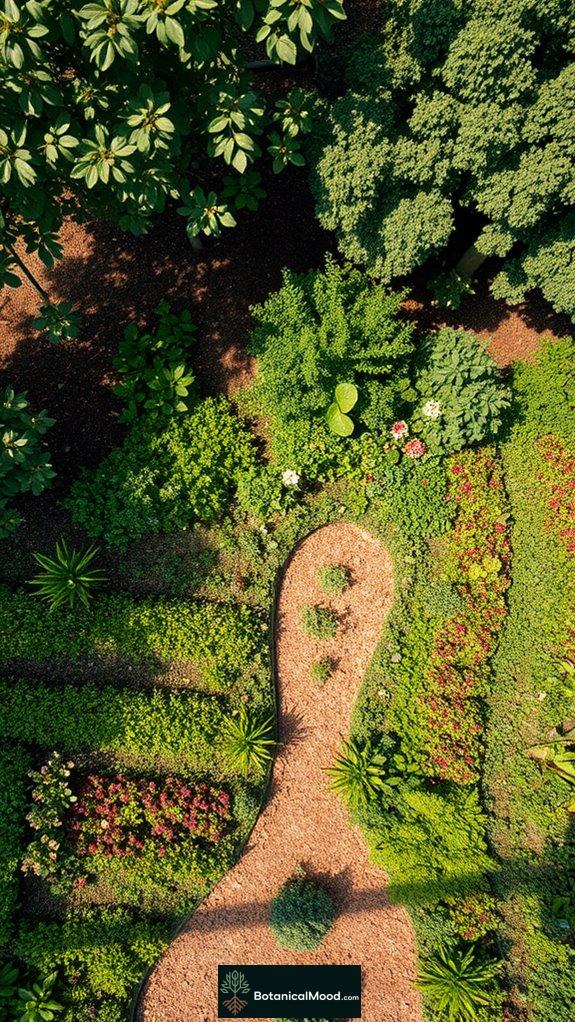
Food forests are like vibrant tapestries woven from nature's rich palette, offering an enchanting way to cultivate abundant harvests while honoring ecological balance. These gardens bring numerous food forest benefits, from enhancing biodiversity to promoting sustainable harvesting. By organizing plants into layers—like tall trees, shrubs, and ground cover—we mimic natural ecosystems, fostering resilience. Food forests operate through layered planting to maximize space and resource use, creating a self-sufficient system that produces food year-round. Sustainable permaculture gardens often utilize companion planting, which further enhances productivity and pest management. I've witnessed how these systems create low-maintenance environments that thrive with little intervention. In nurturing this balanced approach, I've found inspiration for my website, Botanical Mood, where I share perspectives on creating beautiful, productive spaces that harmonize with nature and empower communities through sustainable practices.
Herb Spirals for Efficient Growing
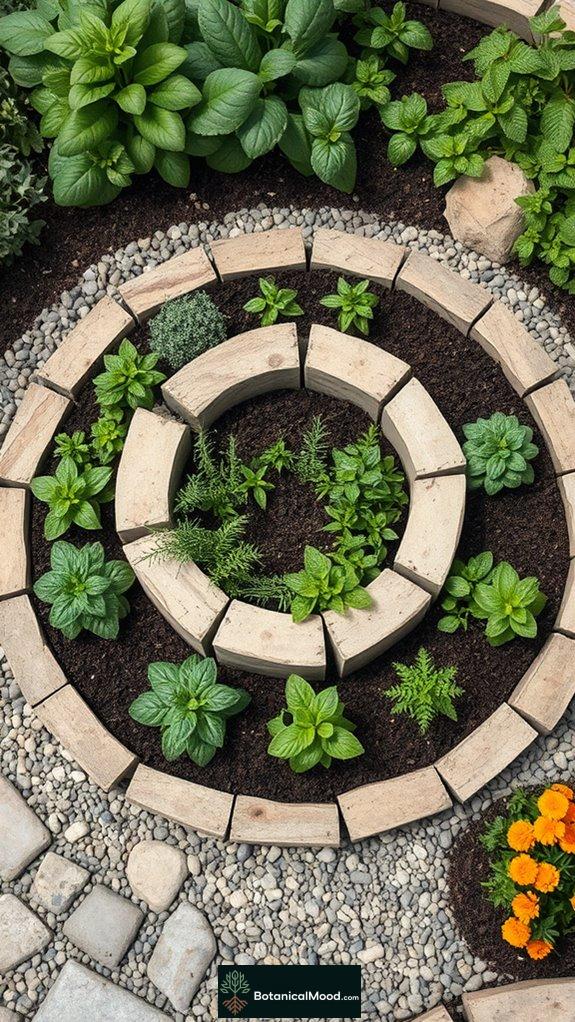
When designing a garden, I often find myself drawn to the enchanting concept of herb spirals, which not only maximize space but also create a stunning visual centerpiece. These spirals utilize innovative herb placement strategies, allowing diverse herbs to thrive in varying microclimates. The spiral benefits include natural drainage and thermal mass, which help retain warmth, making them perfect for cooler climates. Additionally, herb spirals can accommodate various microclimates for different plants, enhancing biodiversity in your garden. Integrating companion planting techniques within these spirals can further boost yields and create a harmonious ecosystem. Plus, they require minimal maintenance while offering high yields. Incorporating recycled materials adds charm and sustainability to the design, which is why I created this website, Botanical Mood, to inspire others to explore these enthralling gardening techniques.
Vertical Gardens for Space Maximization

Vertical gardens captivate me, not just for their aesthetic appeal, but for their remarkable ability to transform limited spaces into lush green oases.
Vertical gardens enchant me, showcasing their power to turn small spaces into vibrant, green retreats.
These innovative gardens offer incredible vertical garden benefits, including:
- Maximizing space in small areas
- Improving air quality with fresh plants
- Enhancing urban aesthetics with vibrant greenery
While vertical garden maintenance may seem challenging, options like modular planters and hydroponic systems simplify the process, making it accessible for anyone. Additionally, efficient use of space allows urban dwellers to create their own green retreats without sacrificing precious square footage. By incorporating diy vertical gardening techniques, you'll find that even the smallest apartment terrace can become a flourishing garden paradise.
I created Botanical Mood to inspire others to embrace these creative gardening solutions, bringing nature's beauty to even the tiniest of spaces.
Let's cultivate our green dreams together!
Container Gardens for Urban Living

Container gardens are an innovative solution for maximizing limited urban spaces, like balconies and rooftops. It allows us to grow a variety of plants, making every inch count while promoting urban sustainability. With easy maintenance, I find that containers reduce weeding and provide better control over soil and drainage. Plus, I can move them indoors during harsh weather, ensuring a year-round gardening experience. Additionally, compact urban micro-gardens can enhance biodiversity by attracting beneficial insects and creating a more sustainable ecosystem.
Rainwater Harvesting Systems
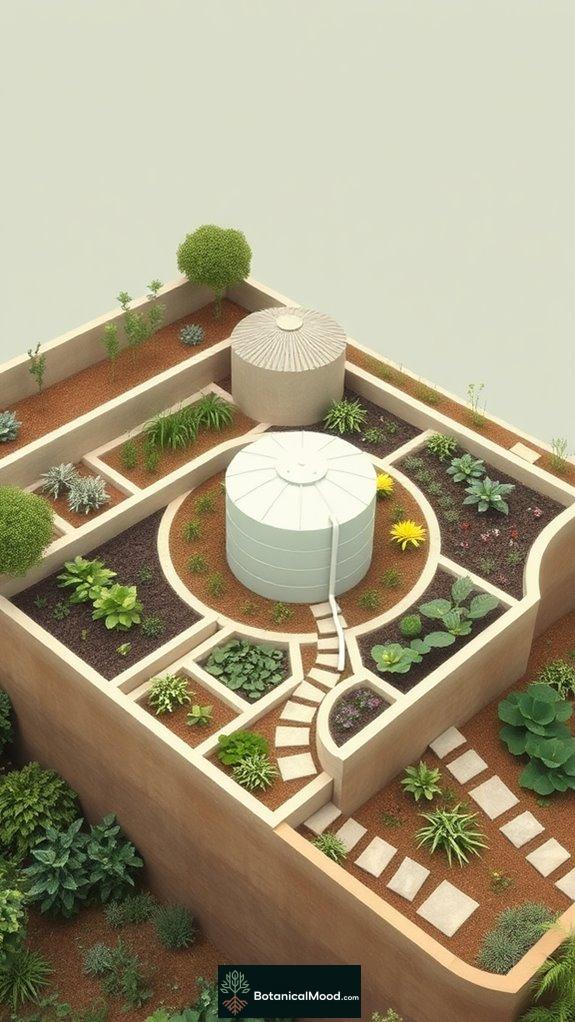
Rainwater harvesting systems not only provide an eco-friendly solution to manage water resources, but they also enrich our gardens by ensuring a sustainable supply for plants.
Rainwater harvesting systems offer an eco-friendly way to manage water and nurture our gardens sustainably.
When I integrated this system into my garden, I noticed significant improvements in water efficiency.
Here are a few key components to take into account:
- Collection Area: Your roof acts as the main catchment.
- First Flush Diverter: This enhances rainwater filtration by diverting initial runoff.
- Storage Tanks: Choose materials that suit your garden's aesthetic and storage needs.
Additionally, implementing a rainwater management strategy can optimize your garden's water usage and enhance its sustainability.
Polyculture Designs for Biodiversity

While exploring the complex world of gardening, I've discovered that incorporating polyculture designs can truly transform a garden into a vibrant ecosystem.
By growing multiple species together, I enhance biodiversity benefits and promote ecosystem resilience. This approach mimics natural systems, fostering mutualistic relationships among plants and animals.
I've noticed that polycultures improve soil health and water use efficiency, while also providing better pest management. With careful planning and diverse plant selections, my garden thrives, attracting a variety of wildlife.
Using companion planting techniques can further optimize plant relationships, enhancing overall garden health.
Through my journey, I created Botanical Mood to inspire others to embrace these innovative designs for sustainable living.
Companion Planting Schemes

Companion planting schemes offer a fascinating way to enhance the health and productivity of your garden, as these strategic pairings can reveal a range of ecological benefits.
Explore the wonders of companion planting to boost your garden's health and productivity through thoughtful plant pairings.
By understanding companion plant benefits, I've transformed my garden into a thriving ecosystem. Here are a few effective companion plant pairings I've found particularly useful:
- Corn, beans, and squash provide support and shade.
- Marigolds repel harmful pests around tomatoes.
- Basil enhances the growth of peppers while repelling pests.
These combinations not only optimize space but also create a balanced environment, making gardening a joyful and innovative experience I love to share through Botanical Mood. Additionally, implementing permaculture principles can further enhance the synergy between these plants and their environment.
Edge Planting for Enhanced Diversity
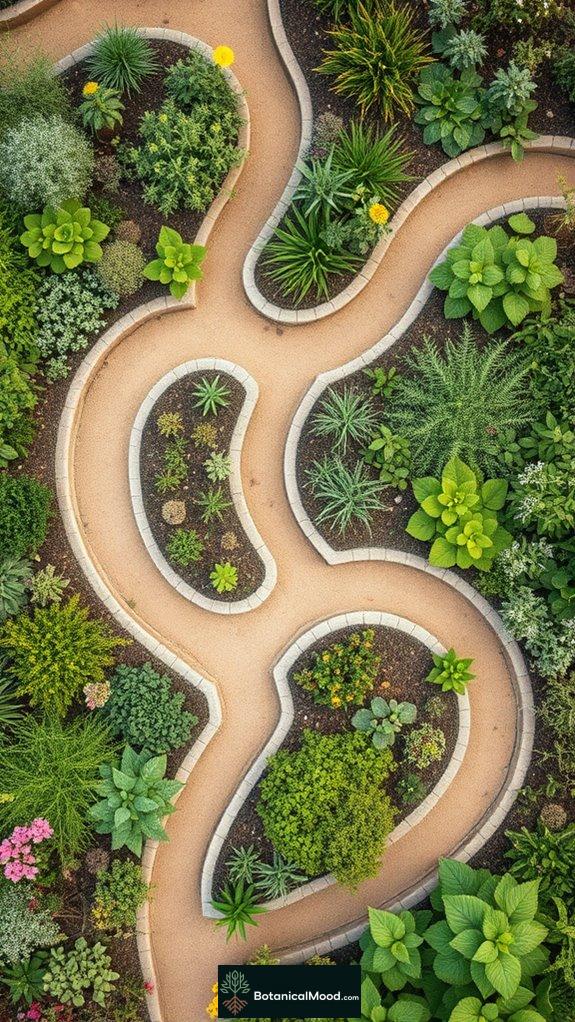
Edge planting serves as an enchanting approach to enhance biodiversity in gardens, creating vibrant ecosystems that thrive on the interaction of various plant species.
By utilizing edge diversity, I've witnessed remarkable habitat connectivity and ecological stability in my own garden.
The microclimate benefits at these boundaries promote species abundance, while resource interaction boosts soil fertility and water retention.
Incorporating permaculture principles, I design curvy garden beds and winding paths that maximize edge productivity, leading to a flourishing environment.
Additionally, embracing native wisdom allows for the integration of local plants that naturally support the ecosystem, further enhancing garden resilience.
Raised Bed Gardens for Accessibility
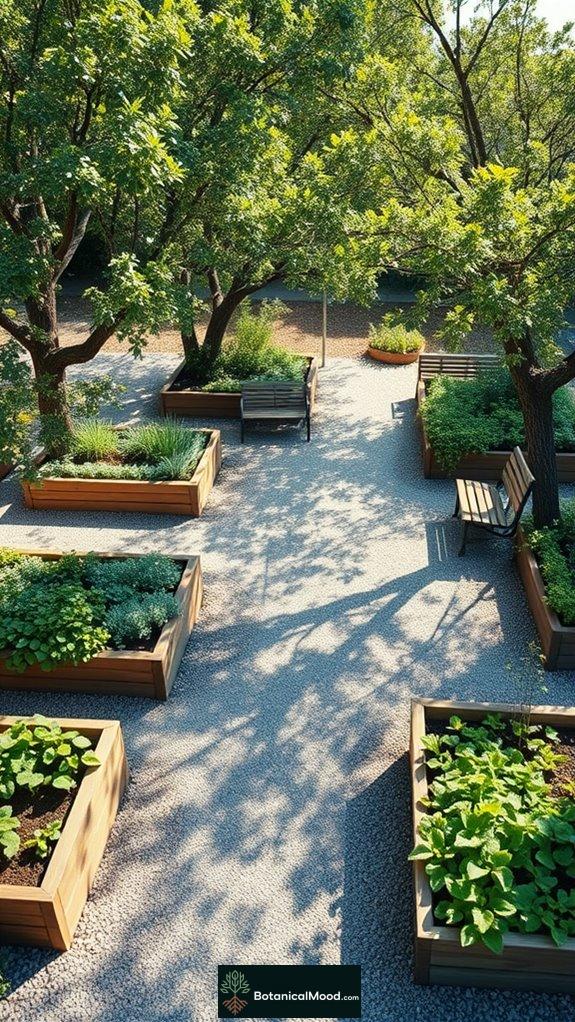
Raised bed gardens offer a wonderful solution for those seeking both beauty and accessibility in their gardening endeavors.
These innovative designs enhance raised bed accessibility, making wheelchair gardening a fulfilling experience.
I love how they allow for seamless gardening without the struggle of bending over.
- Beds should be 28 to 34 inches tall.
- Wide, hard-surfaced paths guarantee safe movement.
- Incorporating shaded seating areas promotes comfort.
Swales for Water Management
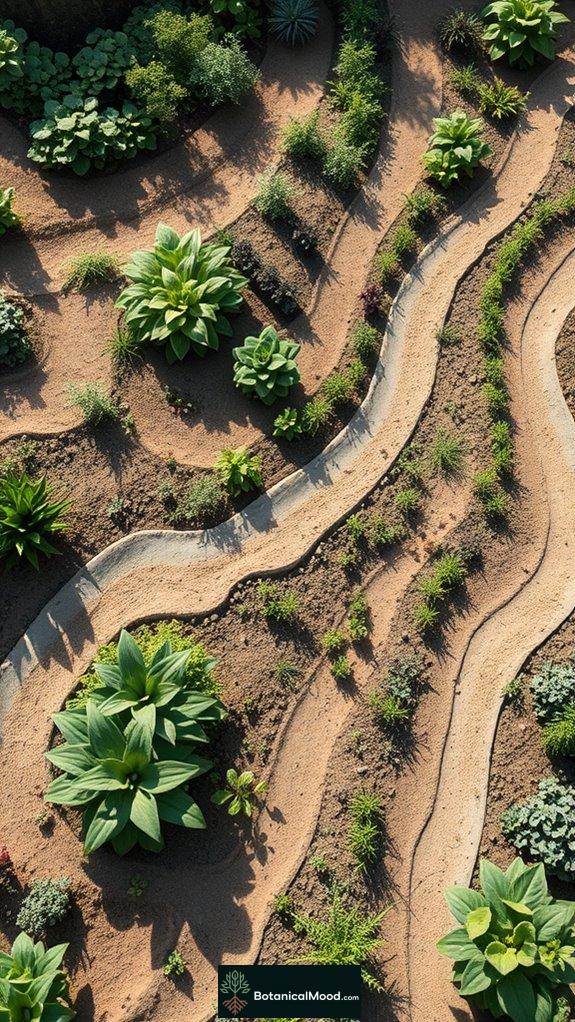
Implementing swales in your garden design can dramatically enhance your water management strategy.
By capturing and slowing down rainwater, swales allow it to infiltrate your soil, improving moisture retention and reducing erosion.
Swales capture rainwater, promoting soil infiltration, enhancing moisture retention, and minimizing erosion for healthier gardens.
I've discovered that proper swale maintenance, like regular inspections and managing swale vegetation, can maximize their effectiveness.
These innovative water management systems create stable microclimates, supporting diverse plant life even in challenging conditions.
Plus, they help regenerate environments by enhancing soil fertility. Additionally, incorporating xeriscaping principles into your garden can further optimize water conservation efforts.
At Botanical Mood, I aim to inspire others to embrace such sustainable practices in their gardens, creating beautiful, resilient ecosystems for all.
Native Plant Gardens for Resilience

When you choose to incorporate native plants into your garden, you're not just beautifying your space; you're also creating a resilient ecosystem that thrives in harmony with local conditions.
Embracing native plant benefits fosters sustainable landscaping that's both beautiful and functional.
Consider these advantages:
- Reduced maintenance due to their adaptation to local climates.
- Support for biodiversity, providing essential habitats for wildlife.
- Erosion control through deep root systems that stabilize soil.
Additionally, native gardens can attract and support pollinators like bees and butterflies, which are vital for ecosystem health.
Permaculture Zones for Efficient Layouts

Creating a garden that harmonizes with its surroundings is a rewarding journey, one that can be enhanced by understanding permaculture zones and their efficient layouts.
By organizing your garden into zones, you'll achieve zone synergy, ensuring that each area serves its unique purpose while maximizing spatial efficiency.
Organizing your garden into zones fosters synergy, allowing each area to thrive while optimizing space and purpose.
Zone Zero, your home, integrates daily practices like indoor gardening, while Zone One focuses on high-yield vegetable patches.
As you expand into Zones Two and Three, consider mixed farming for biodiversity.
This thoughtful arrangement not only optimizes energy use but also allows for easy maintenance, fostering a flourishing ecosystem that I aim to inspire through Botanical Mood. Additionally, implementing sustainable practices can significantly improve the resilience of your garden.
Composting Areas for Soil Health
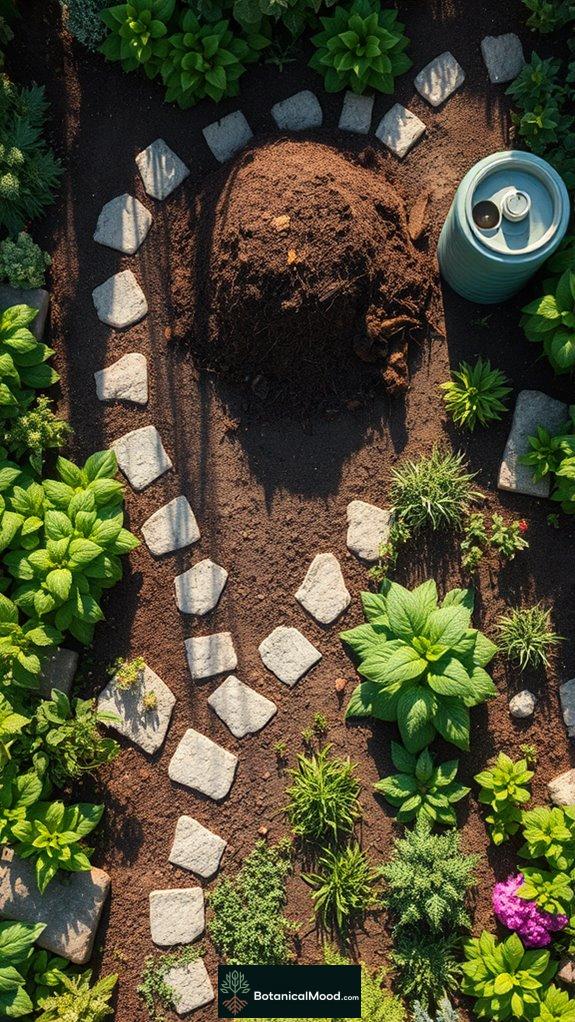
A well-designed composting area can transform your garden into a thriving ecosystem, enriching the soil while reducing waste.
I've found that effective compost pile maintenance is key to revealing composting benefits.
Here are three essential tips I swear by:
- Balance carbon and nitrogen sources for ideal decomposition.
- Turn the pile regularly to enhance aeration and speed up the process.
- Keep moisture at levels similar to a wrung-out sponge to maintain microbial activity.
Creating a composting area not only nurtures your garden but also supports sustainable living, which is why I started Botanical Mood. Additionally, incorporating sustainable water conservation techniques can further enhance your garden's health and resilience.
Wildlife Habitats for Ecosystem Support

As gardens flourish, they can become essential habitats that support local wildlife and enhance biodiversity. I believe that integrating native plants creates vibrant ecosystems, offering food and shelter throughout the seasons. Establishing wildlife corridors is vital for habitat connectivity, allowing species to move safely between spaces. Additionally, creating a sustainable native pollinator garden can significantly boost pollinator populations and overall ecosystem health.
Sustainable Garden Design Concepts
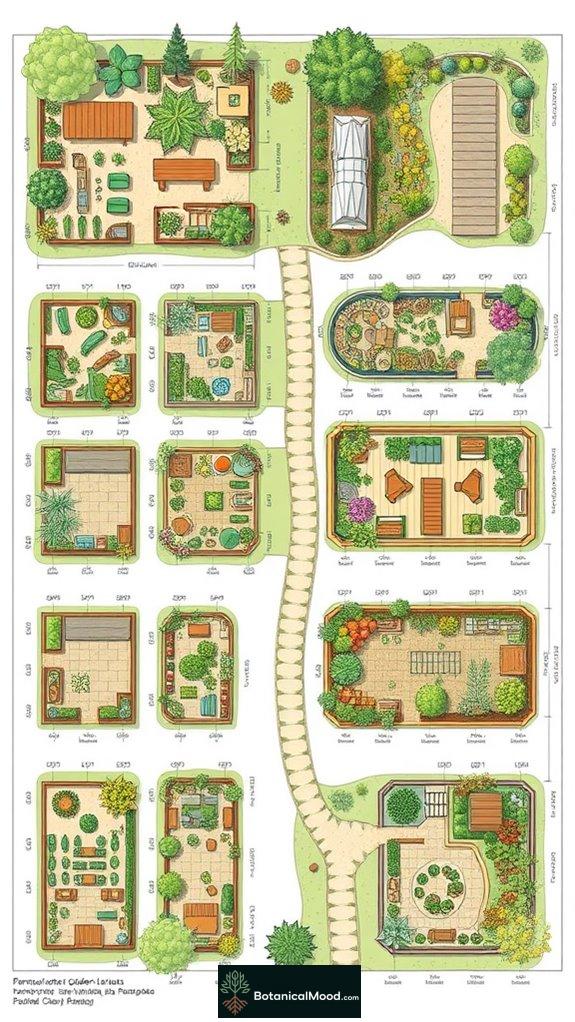
Sustainable garden design concepts emphasize the harmonious relationship between our gardens and the environment, reflecting the beauty and functionality that nature can offer.
By embracing sustainable landscaping and ecological aesthetics, we can craft spaces that not only look stunning but also thrive in their ecosystems.
Here are a few key ideas to take into account:
- Native plants that boost local biodiversity
- Water-saving features like rainwater harvesting
- Recycled materials for garden structures
These principles not only enhance our gardens but also support the earth, which inspired me to create Botanical Mood, a space dedicated to innovative gardening solutions. Additionally, incorporating permaculture principles can significantly increase the sustainability and resilience of our garden designs.
Permaculture Garden Design Blueprints

When exploring the complex world of permaculture garden design blueprints, I find it essential to appreciate how these layouts blend functionality with ecological harmony.
By applying permaculture principles, I can create innovative designs that enhance biodiversity and sustainability. Using design techniques like layered planting and companion planting, I maximize space and improve soil health. I also prioritize water conservation by implementing rainwater catchment systems. Each blueprint I create considers different zones, ensuring efficient use of the garden. This approach not only nurtures the environment but also inspires creativity, which is why I started Botanical Mood—to share this passion for sustainable gardening. Additionally, integrating permaculture design techniques into my layouts allows for a more resilient ecosystem.
Eco-Friendly Backyard Designs
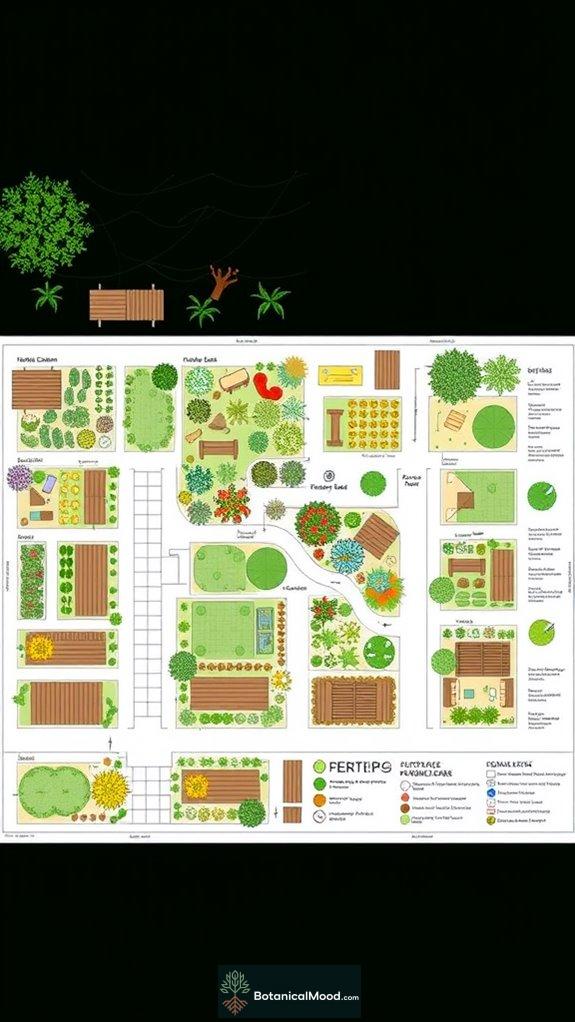
How can we transform our backyards into eco-friendly havens that not only beautify our surroundings but also support local ecosystems?
By embracing sustainable landscaping, we can create spaces that thrive with life. Here are some ideas to inspire your design:
- Incorporate native plants to foster biodiversity and reduce maintenance.
- Install solar lighting to illuminate pathways while conserving energy.
- Use organic mulching to retain moisture and suppress weeds naturally.
Utilizing eco-friendly materials like reclaimed wood or permeable pavers enhances the aesthetic while promoting sustainability.
I created this website, Botanical Mood, to share innovative ideas that help us connect with nature and our environment.
Garden Maintenance Responsibilities

Garden maintenance responsibilities encompass a range of tasks that secure the health and beauty of outdoor spaces, allowing them to flourish throughout the seasons.
Regular garden observation helps identify potential issues early, while seasonal planning guarantees that maintenance tasks align with changing weather patterns and soil conditions.
Essential tasks like mulching, composting, and weeding play pivotal roles in sustaining a vibrant garden.
Utilizing tools like gardening calendars aids in tracking progress and scheduling responsibilities.
References
- https://jardinfeuillesdevie.com/permaculture/
- https://www.skh.com/thedirt/permaculture-gardening-guide/
- https://www.thecelticfarm.com/permaculture-garden/
- https://livingpermaculturepnw.com/permaculture-garden-design-ideas-for-every-situation/
- https://www.ecofriendlyhomestead.com/sustainable-garden/learn/integrate-permaculture-design-with-regenerative-gardening-a-complete-guide
- https://greenly.earth/en-us/blog/ecology-news/food-forest-what-is-it-and-why-is-it-interesting
- https://ourinspiredroots.com/how-to-create-a-food-forest-or-forest-garden/
- https://www.permalogica.com/post/food-forests-in-permaculture-an-in-depth-guide
- https://permacultureapprentice.com/creating-a-food-forest-step-by-step-guide/
- https://www.citygreenonline.org/permaculture-food-forest


